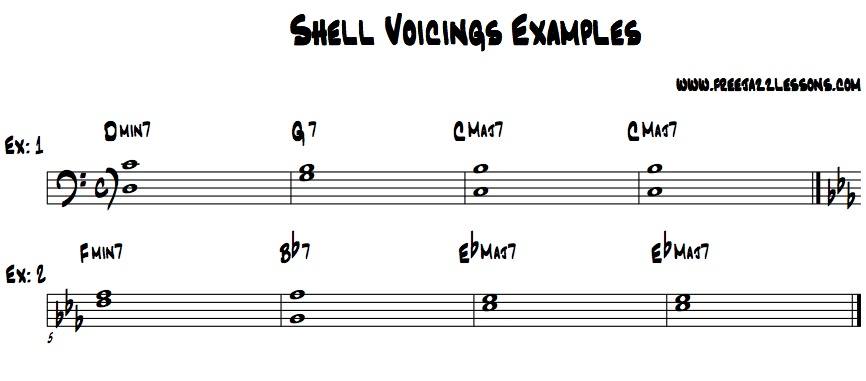Shell Voicings Lesson – Super Simple Yet Powerful Jazz Chords
 Have you ever wondered what shell voicings are? Do you ever wonder what chords people like Bud Powell, Barry Harris, and Al Haig play in their left hand when they’re soloing in their right hand?
Have you ever wondered what shell voicings are? Do you ever wonder what chords people like Bud Powell, Barry Harris, and Al Haig play in their left hand when they’re soloing in their right hand?
Well, most of the time they are using a particular type of chord voicing known as shell voicings.
Shell voicings are super simple to play but really powerful when used correctly. You can use them in jazz, blues, funk, and even certain rock styles.
They’re great chord voicings for beginners to play (they’re only 2 note voicings) but can be used by professional too. They’re simple but powerful!
I’m going to teach you how to play them in just a second but before that you must check this video out of Bud Powell soloing while using shell voicings.
He’s playing on the tune There Will Never Be Another You. He pretty much uses them exclusively when he’s soloing.
Bud Powell’s solo starts at 57 seconds in.
Now you know how they sound. Pretty cool right? Scroll down for some important tips on how to build them and practice them.
How To Play Shell Voicings
The theory behind shell voicings is super simple. For the most part they are 2 note voicings. For each chord you play the root of the chord as your lowest note.
The second note will be either the 3rd or 7th of the chord. And that’s it. Simple right?
They are purposely left sparse so you can do more interesting things in the right hand while you’re soloing.
Here’s are 2 examples of them in a II – V- I chord progression.
 How To Build Shell Voicings
How To Build Shell Voicings
Pay special attention to how each note inside a chord leads smoothly into the next chord. Not only does this sound good but it also makes it easy for our hands to play these chords.
For example check out:
Notation Example 1:
- The root is on the bottom and the 7th is on top on the Dmin7.
- It then voice leads to the G7 (root on the bottom 3rd on top) and then moves to Cmaj7 (root on the bottom and seventh again on top).
Notation Example 2:
- The root is on the bottom and the 3rd on top on the Fmin7.
- It then voice leads to the Bb7 (root on the bottom 7th on top) and then moves to Ebmaj7 (root on the bottom and 3rd again on top).
They tend to work best when there is a particularly active and rhythmically interesting right hand.
They essentially outline the bare essentials of the harmony and leave plenty of space for an expressive right hand solo.
That’s why they were super popular in the bebop era and even still today.
How Do You Practice Shell Voicings?
Here are 3 recommendations:
1. Shell Voicings In Tunes
Take a couple jazz standards and build a simple arrangement just using shell voicings in your left hand.
![]() Need help with this? There are several hours of tutorials inside The Premium Membership Course that teach you how to apply easy jazz piano chords into real jazz tunes.
Need help with this? There are several hours of tutorials inside The Premium Membership Course that teach you how to apply easy jazz piano chords into real jazz tunes.
2. Use Them While Improvising
Practice soloing through a couple tunes you know really well so you don’t have to think about the chord changes.
Force yourself to only use the shell voicings while you improvise simple ideas in the R.H. Shell voicings work particularly great when using jazz improvisation techniques from the bebop era and even when improvising blues piano.
Learn From The Masters
3. Transcribe a couple choruses of a Bud Powell or Barry Harris solo and take a listen to how they use shell voicings. If you need a starting point here’s a Barry Harris solo for your to check out.
4. Once you master shell voicings make sure you check out this lesson on rootless voicings for the left hand. You can also check out this voicing lesson on two handed chord voicings.
By the way, here’s a list of recommend jazz standards to learn. Here’s another helpful list of jazz tunes to learn as well.
******
If you are new here be sure to subscribe to the free jazz lessons email. You’ll receive all the latest free lessons as soon as they’re released.
You can sign up right on the top left of the website or right below this article.
